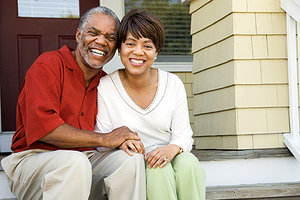I want to give Dr. Claudia Anrig kudos for her Dec. 1, 2014 column, which highlighted safety issues youngsters might encounter in the home.1 Not surprisingly, since Dr. Anrig focuses her care on the pediatric patient, much of her attention was directed at suggestions to make children safer in the home. We should also consider similar changes to make the home environment safer for older people. After all, growing older is somewhat like being a baby in reverse.
Shifting Demographics Calls for Shifting Prevention Priorities
As stated, the population (particularly in the industrialized world) is aging rapidly. In fact, the life expectancy in the United States went from roughly 47 years of age in 1900 to an amazing 76 in the year 2000. That's an increase of nearly three decades. Part of this rise in longevity can be attributed to better treatment for many of the acute and infectious diseases we used to succumb to; as well as improved infrastructure (e.g., clean drinking water), seat-belt laws, and smoke alarms, just to name a few. (Alarmingly, the youngest generation is the first group in history that actually has a shorter life expectancy than their parents. But that's another story.)
Of course, part of the trade-off for living longer is more time to develop chronic, debilitating diseases such as heart disease, cancer and diabetes. It has been said that we're now living long enough to get sick.
 The "Aging in Place" Trend and Our Need to Adapt
The "Aging in Place" Trend and Our Need to Adapt
Given the fact that we are living longer, and as I understand things, Social Security is about to run out of money, there is an increasing tendency for older people to want to remain in their homes as long as they can – sometimes out of desire, sometimes out of financial necessity. This trend is often referred to as "aging in place" and has many benefits, not the least of which is financial. Simply put, it's less costly to stay in a home than to move into a retirement home. Plus, it's much more satisfactory.
To facilitate this desire to remain in the home for as long as possible, it is necessary to apply similar steps for our elderly patients that Dr. Anrig suggests for children. I recently wrote a book titled Age-Proof Your Home: Room by Room. In the book, I go through each room in a few typical houses, identifying various things that might be hazardous to the older individual and offering suggestions to make things safer. As one might expect, some houses are "safer" than others. Many of the suggestions are similar to those Dr. Anrig suggested for children. They include:
- Removing or taping down loose-fitting area rugs
- Removing electrical extension cords
- Ensuring doorways and hallways are wide enough to accommodate canes and wheelchairs
- Installing handrails in all bathrooms
- Using nonslip mats in showers and bathtubs
- Replacing broken / dim light fixtures
- Getting rid of "clutter"
While these are not the sum total of the changes that can and should be made, they represent a pretty good start. By the way, many of the changes can be made with little or no expenditure. They are simply common sense (e.g., removing clutter). Other steps may require some money (e.g., widening doorways). However, in these days of rising health care costs, the money is easy to justify.
Elderly Falls: Causes, Prevention
One of the most critical health problems the older generation faces is falls. Falling is associated with considerable mortality, morbidity, reduced functioning, and premature nursing-home admissions. In fact, one study found that falls were a major reason for 40 percent of nursing-home admissions.2 Many falls are needless and occur because of lack of foresight on the part of the homeowner.
A key concern is not just the incidence of falls in the elderly, but the combination of high incidence and high susceptibility to injury. Approximately 5 percent of older people who fall require hospitalization. Falls usually result from an interaction of multiple and diverse risk factors:
- Muscle weakness
- A history of falls
- Gait and/or balance deficits
- Use of an assistive device (e.g., cane or walker)
- Visual deficits
- Arthritis
- Impaired activities of daily living (ADL)
- Depression
- Cognitive impairment
- Age (80-plus years)
- Medication (particularly polypharmacy)
It has been said that the percentage of individuals who fall increases from 27 percent for those with one risk factor or less to 78 percent for those with four or more risk factors. Obviously, the more risk factors, the greater the likelihood of falling. Additionally, Robbins, et al., demonstrated that the likelihood of falling in a one-year period ranged from 12 percent for those without any of three risk factors (hip weakness, unstable balance, or taking four or more medications) to 100 percent for those with all three.
Share the following tips with your patients (elderly patients and patients with elderly family members) to reduce the risk of falls and subsequent injury:
- Indoor lighting: Make sure stairways and hallways have bright light; always try to use the highest wattage allowed in the fixture. Night lights for those middle-of-the-night trips to the bathroom also can make a big difference in preventing falls.
- Outdoor lighting: Use all the available outdoor lights whenever possible; sensor lights are available that will turn on whenever there's exterior movement.
- Clutter: Just having things "out of place" or "lying around" can cause falls; when objects are out of their normal place, they can be overlooked and tripped over.
- Extension cords: Find a way to arrange furniture / plug-in accessories so extension cords are out of the way.
- Handrails: Don't use the soap or towel holder for a grab bar or handrail. Use handrails on all steps, no matter how easy the steps are to climb or how many times you've been up and down them before.
- Rugs: Be sure all throw rugs or scatter rugs have a nonskid backing to prevent slippage.
- Pets: Be aware of where your pet is and be careful when visiting others who have pets.
- Walking surfaces: Be sure to avoid broken sidewalks or areas under construction, if at all possible.
Mother Nature also presents many hazards when it comes to the risk of falling. Snow is the greatest culprit. To reduce the risk, always park your car in an area clear of snow and ice. In addition, try to limit driving to daylight hours so you are able to see any patches of ice on the streets and in the parking lots.
It's important to note that while falls are not the only problem that the elderly encounter, many of the changes to reduce the risk also reduce the risk of other injuries, both to the senior population and to other age groups.
Becoming a Baby in Reverse
I have a rather new grandson. I've been fortunate enough to watch him grow through the first year and a half of his life. It has been a real treat (and very informative) to observe his maturation. As he grows, he gains more independence. He was initially dependent upon his parents for everything (moving, feeding, toileting, etc.). Now he likes to feed himself and walk everywhere. In just a few short years, he'll learn to ride a bicycle and then drive a car. Eventually, he'll move out and start his own family.
At the same time that I've watched my grandson develop, I've started to feel the pangs of old age. My senses aren't what they used to be and I'm becoming more dependent upon others to help me do things I used to take for granted. In other words, getting older is like being a baby in reverse.
With that in mind, it is imperative that we show the same concerns for our elderly patients that we do for the younger ones. After all, age-proofing the house is not just to keep children safe – it's for everyone.
References
- Anrig C. "Home Safety: Help Families Avoid Common Injury Hazards at Home." Dynamic Chiropractic, Dec. 1, 2014.
- Bezon J, Echevarria KH, Smith GB. Nursing outcome indicator: preventing falls for elderly people. Outcomes Manag Nurs Pract, 1999 Jul-Sept;3(3):112-6.
- Robbins AS, Rubenstein LZ, Josephson KR, Schulman BL, Osterweil D, Fine G. Predictors of falls among elderly people. Results of two population-based studies. Arch Intern Med, 1989 Jul;149(7):1628-33.
Click here for previous articles by Paul Hooper, DC, MPH, MS.





